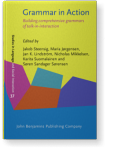Chapter 4
Grammatical formats of requests for immediate actions
Observations on Danish talk-in-interaction
This chapter investigates three social action formats for
requesting immediate action in Danish talk-in-interaction:
embodied-only formats, phrasal formats, and modal verb formats. The
analyses of the use of these formats are serve as a basis for
discussing how entries in a comprehensive grammar of Danish
talk-in-interaction should be organized and written. This is related
to an ongoing project to develop such a grammar (DanTIN 2024). I focus on the
consequences of the analyses for concrete entries in the grammar,
and for the use of concepts such as multimodality, ellipsis,
interrogativity, and sequentiality in the grammar. I argue that some
nonverbal formats must be included in the grammar, and I suggest how
this can be done. I also argue that sequence organization must be
part of a syntactic description, and that the centrality of some
traditional syntactic concepts must be reconceptualized.
Article outline
- 1.Introduction
- 1.1Social action formats
- 1.2The grammar
- 1.3Requests and grammar
- 1.4Chapter overview
- 2.Data and focus
- 3.Analyses of three formats and their implications for grammar
writing
- 3.1Embodied-only requests
- 3.1.1Embodied-only requests as social action formats
- 3.1.2Embodied-only formats in the comprehensive
grammar
- 3.2Phrasal or subsentential requests
- 3.2.1Item-only requests
- 3.2.2Phrasal action-guiding requests
- 3.2.3Phrasal requests in the comprehensive grammar
- 3.3Modal verb request formats
- 3.3.1Self-referencing modal verb request formats
- 3.3.2Other-referencing modal verb request formats
- 3.3.3Modal verb request formats in the Comprehensive
Grammar
- 4.Discussion and conclusion
-
Acknowledgements
-
Notes
-
References
This content is being prepared for publication; it may be subject to changes.
